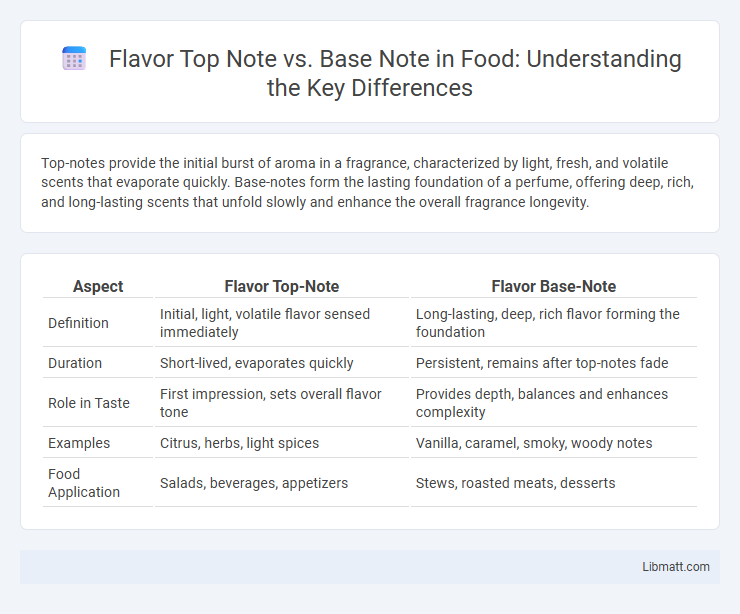Top-notes provide the initial burst of aroma in a fragrance, characterized by light, fresh, and volatile scents that evaporate quickly. Base-notes form the lasting foundation of a perfume, offering deep, rich, and long-lasting scents that unfold slowly and enhance the overall fragrance longevity.
Table of Comparison
| Aspect | Flavor Top-Note | Flavor Base-Note |
|---|---|---|
| Definition | Initial, light, volatile flavor sensed immediately | Long-lasting, deep, rich flavor forming the foundation |
| Duration | Short-lived, evaporates quickly | Persistent, remains after top-notes fade |
| Role in Taste | First impression, sets overall flavor tone | Provides depth, balances and enhances complexity |
| Examples | Citrus, herbs, light spices | Vanilla, caramel, smoky, woody notes |
| Food Application | Salads, beverages, appetizers | Stews, roasted meats, desserts |
Introduction to Flavor Top-Note and Base-Note
Flavor top-notes are the initial scents or tastes that you experience immediately upon exposure, often light, fresh, and volatile, creating the first impression of a flavor profile. Base-notes form the foundation of the flavor, emerging after the top-notes fade, providing depth, richness, and lasting complexity with heavier, longer-lasting elements. Understanding the distinction between top-notes and base-notes helps you appreciate the full evolution of flavors in food, beverages, or fragrances.
Defining Top-Notes in Flavor Profiles
Top-notes in flavor profiles refer to the initial, lighter scents or tastes that are immediately perceived upon first exposure, often characterized by their volatility and freshness. These fleeting aromas, such as citrus, herbal, or fruity elements, create the first impression and set the tone for the overall flavor experience. Distinct from base-notes, which provide lasting depth, top-notes evaporate quickly but are crucial for the initial appeal and complexity of a flavor profile.
Understanding Base-Notes in Culinary Creations
Base-notes are the foundation of flavor profiles in culinary creations, providing depth and longevity to dishes. These rich, lasting flavors often include ingredients like vanilla, musk, amber, or dark spices, which emerge more slowly but persist throughout the tasting experience. Understanding base-notes allows chefs to create balanced recipes by anchoring brighter top-notes with subtle, complementary undertones.
Key Differences Between Top-Note and Base-Note
Top-notes in fragrances are the initial scents you perceive, characterized by light, volatile, and fresh aromas like citrus or herbs that evaporate quickly. Base-notes form the lasting foundation of a perfume, providing depth with rich, heavy scents such as musk, amber, or vanilla that linger on your skin for hours. Understanding the key differences helps you choose perfumes that suit your preference for immediate brightness or enduring warmth.
Sensory Impact of Top-Notes vs Base-Notes
Top-notes deliver the initial, vibrant burst of aroma, often consisting of citrus, herbal, or fruity elements that immediately capture sensory attention but tend to dissipate quickly. Base-notes provide depth and longevity, featuring rich, warm, and heavier molecules like vanilla, musk, and woods that anchor the scent and create lasting impressions on the olfactory system. The sensory impact of top-notes triggers immediate emotional response, while base-notes ensure enduring fragrance presence and complexity.
Role of Top-Notes in Food and Beverage Innovation
Top-notes play a crucial role in food and beverage innovation by delivering the initial burst of aroma and flavor that captivates consumers' senses. These volatile compounds evaporate quickly, creating memorable first impressions that influence taste perception and product appeal. Incorporating well-crafted top-notes enhances your product's sensory profile, driving consumer preference and market success.
Importance of Base-Notes for Lasting Flavor
Base-notes form the foundation of a fragrance or flavor profile, providing depth and longevity that ensures the flavor lingers well after the initial taste fades. Essential oils such as vanilla, sandalwood, and musk are common base-notes known for their slow evaporation rate, which enhances the lasting impression of the flavor. Their ability to stabilize and anchor top-notes makes base-notes indispensable for creating a balanced and enduring sensory experience.
How to Balance Top-Notes and Base-Notes
Balancing top-notes and base-notes requires understanding their volatility and longevity; top-notes are light, volatile scents that create the first impression but dissipate quickly, while base-notes are heavier, long-lasting aromas that provide depth and resonance. To achieve harmony, blend a moderate concentration of top-notes like citrus or herbal elements with more substantial base-notes such as vanilla, musk, or sandalwood, ensuring the top-note presence is enough to attract attention without overpowering the base. Proper formulation and testing are crucial to ensure the fragrance evolves smoothly from initial freshness to a lasting, balanced finish.
Examples of Top-Note and Base-Note Ingredients
Top-note ingredients in flavors include citrus fruits like lemon, bergamot, and orange, as well as herbs like basil and mint, which provide the initial burst of freshness and brightness in your sensory experience. Base-note ingredients, such as vanilla, sandalwood, and musk, offer depth and longevity, lingering on the palate or skin as the lasting impression of the flavor or fragrance. Understanding these contrasts helps you select products that balance the immediate appeal with enduring complexity.
Tips for Enhancing Flavor Profiles Using Notes
Top-notes deliver the initial burst of aroma and are typically light, citrusy, or fruity, setting the first impression of the flavor profile. Base-notes provide depth and longevity with rich, heavy scents like vanilla, musk, or amber, anchoring the overall blend and enhancing complexity. Balancing top-notes with complementary base-notes creates a harmonious and memorable flavor experience that evolves over time.
Flavor Top-Note vs Base-Note Infographic

 libmatt.com
libmatt.com